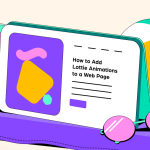
Beyond Aesthetics: The Hidden Impact of CSS Animations on User Experience
- Post
- August 5, 2023
- CSS Animations, HTML & CSS, Web Development
- 0 Comments
In the ever-evolving world of web design, CSS animations have become a powerful tool for enhancing the user experience. Beyond just eye-catching visuals, these animations play a crucial role in how users interact and perceive a website. In this comprehensive blog, we delve into the profound impact of CSS animations on user experience, exploring various examples, animation libraries, and the essential CSS animation properties that can take your website to the next level.
The Psychology Behind CSS Animations
Understanding the psychological aspects of CSS animations is crucial to grasp their impact on user experience. Subtle animations, such as smooth transitions and fading effects, can create a sense of continuity and coherence, making the browsing experience more enjoyable. By providing visual feedback, animations can also reduce cognitive load and aid users in understanding interface changes, ultimately increasing engagement and retention.
CSS Animations and Website Performance
While CSS animations offer a plethora of benefits, website performance can be a potential concern. When used excessively or implemented inefficiently, animations may slow down page loading times. However, employing modern techniques, like hardware acceleration and optimizing keyframes, can mitigate these issues and ensure smooth animations without compromising performance.
Showcasing Your Brand Story with CSS Animations
CSS animations provide an excellent opportunity to showcase your brand’s personality and story. By incorporating animations that align with your brand’s tone, values, and aesthetics, you can create a lasting impression on visitors. Subtle animations can express elegance and sophistication, while bold animations can exude creativity and innovation.
The Role of CSS Animation in User Interaction
User interaction is a vital aspect of any website, and CSS animations can significantly impact how users engage with your content. Hover animations, for instance, can provide visual feedback, encouraging users to explore elements they might have otherwise overlooked. Similarly, micro-interactions can make mundane tasks more enjoyable, leading to increased user satisfaction.
Exploring CSS Animation Libraries
To expedite the animation implementation process, developers often turn to CSS animation libraries. These libraries come equipped with pre-built animation templates and effects that can be easily customized to suit your website’s needs. Popular libraries like Animate.css and Hover.css offer a wide array of animations, from simple transitions to complex keyframe-based effects.
The Power of CSS Animation Property: Transition
The CSS ‘transition’ property lies at the core of creating smooth animations. By defining the transition of specific CSS properties, such as color, size, or position, developers can add a polished touch to elements. With smooth transitions, users can perceive changes effortlessly, enhancing the overall user experience.
Bringing Websites to Life with CSS Keyframe Animations
CSS keyframe animations allow developers to create dynamic and engaging animations by specifying multiple points in an animation sequence. By using keyframes, you can design complex animations that breathe life into your website. From loading spinners to interactive elements, keyframe animations offer endless possibilities.
Combining CSS Animations with Interactivity
Integrating interactivity with CSS animations can unlock a world of immersive experiences. With JavaScript, developers can trigger animations based on user actions, creating interactive elements that respond to clicks, scrolls, or hovers. This interplay between user actions and animations adds depth and engagement to the website.
The Mobile-First Approach to CSS Animations
As mobile browsing continues to dominate, adopting a mobile-first approach to CSS animations becomes imperative. Since mobile devices have varying processing power and screen sizes, it’s crucial to optimize animations for smooth performance and seamless user experience on smartphones and tablets.
SEO Implications of CSS Animations
Beyond user experience, CSS animations can impact SEO efforts. While animations themselves may not directly influence search rankings, a positive user experience leads to lower bounce rates, longer session durations, and increased user engagement. These factors indirectly contribute to better search rankings.
Final Words
In conclusion, CSS animations transcend mere aesthetics and significantly influence the user experience of a website. By understanding the psychology behind animations, leveraging the right CSS animation libraries, and optimizing performance, you can create a website that not only delights users but also outranks competitors in search engine results.
Commonly Asked Questions
Q1: Can CSS animations work on all browsers and devices?
A1: Yes, CSS animations are supported on most modern browsers and devices. However, it’s essential to test animations on various platforms to ensure consistent performance.
Q2: Are there any accessibility concerns with CSS animations?
A2: Yes, CSS animations can pose challenges for users with certain disabilities. It’s crucial to provide alternative ways to access content for those who may not experience animations.
Q3: How can I optimize CSS animations for mobile devices?
A3: To optimize for mobile, use hardware-accelerated animations, reduce animation complexity, and test on multiple devices to ensure smooth performance.
Q4: Can CSS animations enhance website conversions?
A4: Absolutely! Well-implemented CSS animations can captivate users, increase engagement, and positively impact conversion rates.
Q5: Are there any SEO-friendly animation practices?
A5: Yes, focus on performance optimization, use animations to enhance user experience, and prioritize mobile-friendliness to align with SEO best practices.




